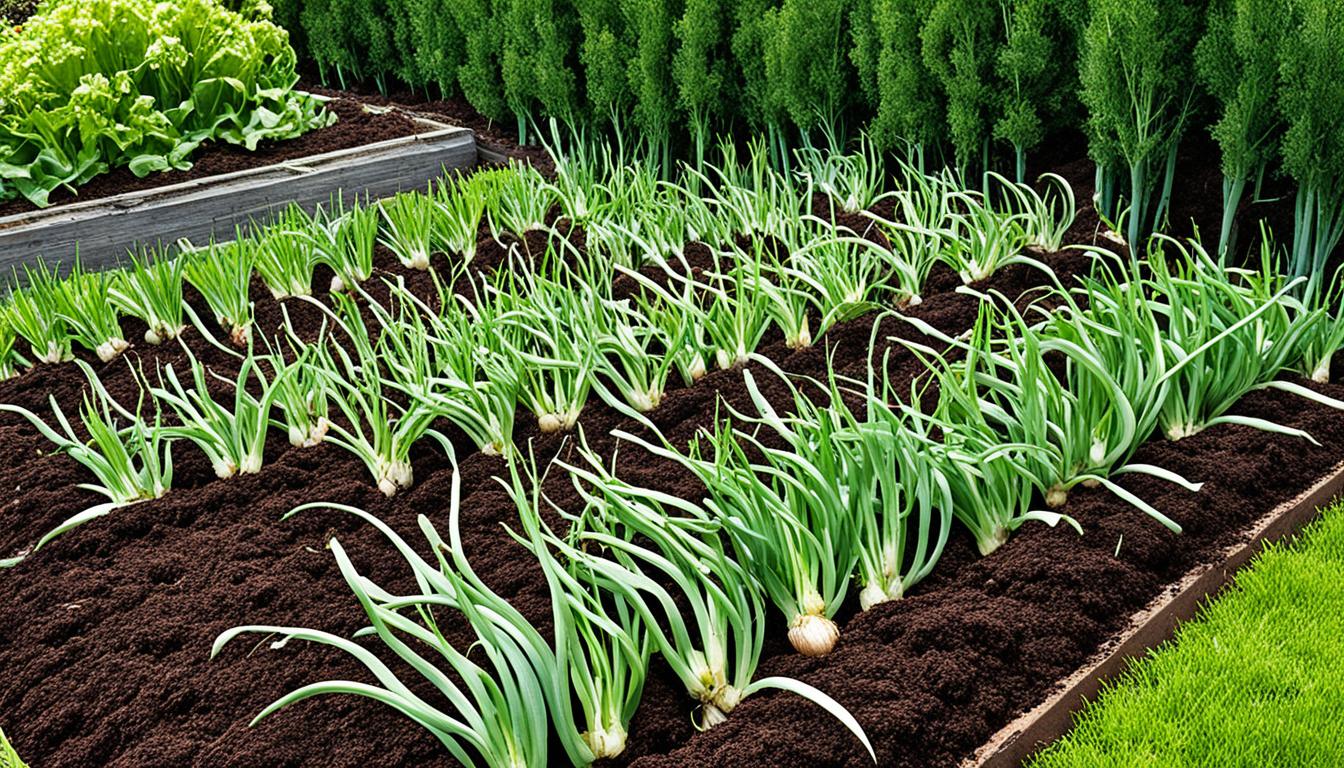As a seasoned gardener, I’ve learned that picking onions at the right time is key for great flavor and keeping them fresh. Onions are a must-have in many gardens. Knowing when they’re ready can greatly improve your harvest. Experts say look for three signs: a soft neck, when the tops fall over, and the last leaf drying out.
The ideal number of leaves for a perfect onion is 13. But, some types can be ready with fewer leaves and still taste great. When onion plants have at least seven leaves, start watching for maturity signs. Harvesting when 85-90% of the tops fall over is a good rule for storing onions.
The neck of the onion should turn dry from green and fleshy to signal readiness. Waiting for the last leaf to dry before pulling onions out of the ground helps prevent rot in storage.
Signs of Maturity to Watch For
As an avid gardener, I’ve learned that harvesting onions at the perfect moment is crucial. It ensures a bountiful and flavorful crop. A key indicator of onion maturity is the leaf count. While 13 leaves is often seen as the “sweet spot,” some onions may mature with fewer leaves and still be great.
When your onion plants reach at least seven leaves, watch for three signs of readiness. These signs are soft neck, tops falling over, and the last leaf indicator.
Leaf Count
The number of leaves on your onion plants tells you about their maturity. As onions grow, the leaves increase in count. While 13 leaves is often cited as ideal, some onions may mature with fewer leaves.
Keep an eye on your plants. Once they have at least seven leaves, start monitoring for other signs of readiness.
Soft Neck
Another important sign of onion maturity is the softening of the neck. This is where the leaves meet the bulb. As onions mature, the neck should start to feel soft to the touch.
This soft neck shows that the transfer of carbohydrates from the leaves to the rings is complete. It’s a clear signal that your onions are ready for harvesting.
Tops Falling Over
When some of the onion tops start to fall over, it’s a strong indicator that your crop is ready for harvest. This happens when onions have reached 100% soft neck, even if not all tops have fallen over yet.
The experts recommend waiting until 85-90% of the tops have fallen over before harvesting. This is especially true if you’re growing onions for storage.

By keeping a close eye on the leaf count, softening of the neck, and the progression of the fallen tops, you can confidently determine when your onions have reached their peak maturity. Paying attention to these key signs will ensure you get the most out of your onion crop.
The Last Leaf Indicator
The last leaf on the onion plant is a key sign for harvesting. As onions grow, the leaves at the base dry out and turn brown from top to bottom. This shows when the onions are ready to be picked.
Looking at the newest leaf, or the “last leaf,” is important. If you pull onions before this leaf dries, they might rot in storage. The top of the onion should be hard and not soft or sunken before you lift it.
Checking the last leaf’s dryness helps you know when onions are ready. This method, along with other signs, makes sure you harvest onions at the best time. It helps you get the most out of your onions.
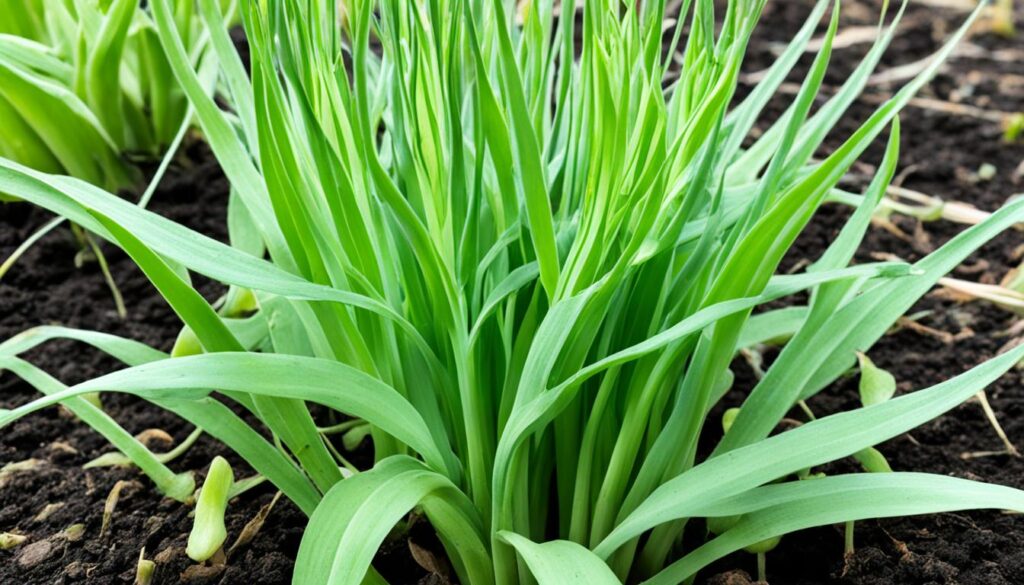
Patience and careful watching are crucial for knowing when to harvest onions. Following the last leaf’s condition ensures a great onion harvest. This way, you get onions that taste good and last a long time.
Timing the Harvest
Harvesting onions at the right time is key for the best quality and storage. Wait for dry weather and when many onion tops have fallen. This ensures your onions are perfect for eating and keeping.
Dry Weather Conditions
Onions do well in dry weather. Harvest them when it’s dry to avoid disease and spoilage. The more mature onions are, the tastier and longer they keep.
Percentage of Fallen Tops
The number of fallen onion tops tells when to harvest. Wait until 50% to 80% of the leaves dry and fall over. This means the onions are fully grown and ready for storage.
Check the neck of the onion for tightness and unmovable layers. This shows they’re ready to be picked. By watching for these signs, you’ll know the best time to harvest your onions.
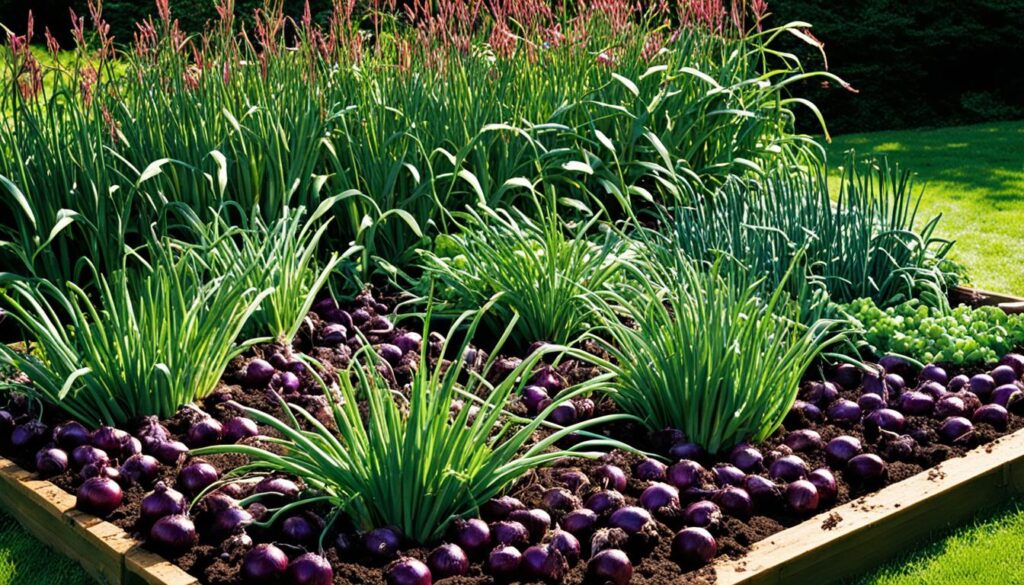
“Harvest mature garden onions before fall rains to prevent rotting. Mature onions should be cured in a warm, well-ventilated place until the outer skin becomes papery and crispy dry.”
Follow these tips for a great onion harvest. Keep an eye on the weather and the fallen tops. This way, you’ll get a lot of delicious onions.
How Can You Tell When Onions Are Ready to Harvest?
Knowing when to pick your onions is key for their quality and how long they’ll last. Look for these signs to know when it’s time to harvest:
- Leaf Count: As onions grow, they lose leaves. Harvest when there are 6-8 leaves left.
- Soft Neck: Check the onion neck for softness. If it feels soft, it’s ready.
- Tops Falling Over: If the onion tops fall over, they’re mature.
The “last leaf” test is also a good way to check. When the last leaf turns yellow and dries, it’s time to pick the onions.
| Indicator | Description |
|---|---|
| Leaf Count | Aim for 6-8 leaves remaining |
| Soft Neck | Neck should feel soft and pliable |
| Tops Falling Over | Green tops start drooping and falling over |
| Last Leaf | Final leaf starts to yellow and dry out |
Harvest onions in dry weather to help them cure faster and last longer. Try to pick them when 50-80% of the tops are dry and down.
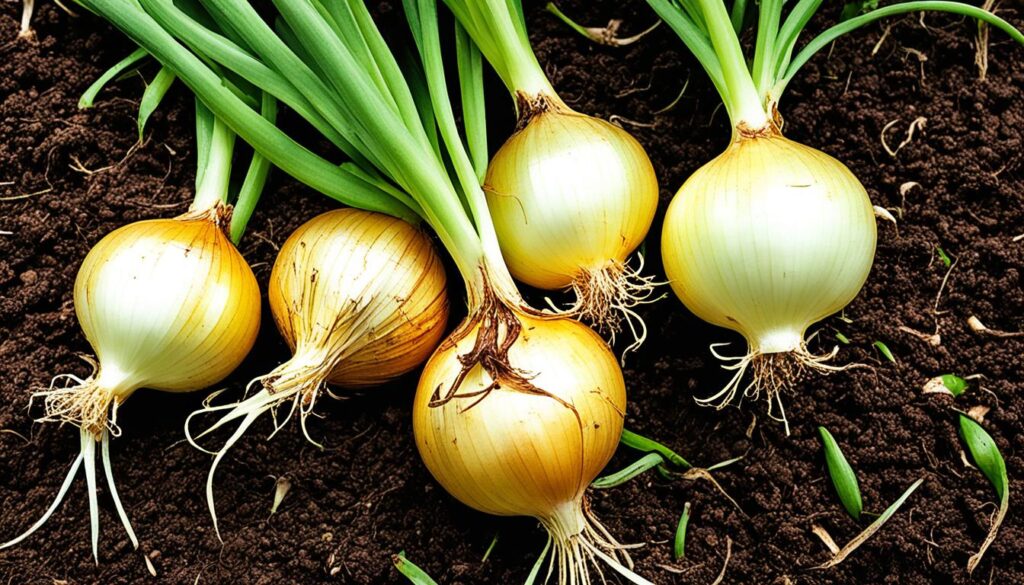
Watch for these signs to know the best time to harvest your onions. This way, you can enjoy their full flavor and make the most of their storage life.
Proper Curing Techniques
Curing onions right is key to keeping them fresh for a long time. The process involves drying the outer skins and necks. This gets the onions ready for storage.
Temperature and Humidity Requirements
Onions need to be cured at a temperature between 75 and 90 degrees Fahrenheit for 2 to 4 weeks. This dries out the outer layers, tightens the necks, and keeps the onions looking good. The best humidity level is around 65%.
Right curing conditions make the onion’s outer layers papery and tight. This stops rot and spoilage. Too much humidity makes roots grow, and high temperatures make them sprout. Both can lower the quality.
Cutting and Sorting Onions
- After curing, trim the onion necks to about 1 inch above the bulb.
- Remove onions with sprouts, disease, or damage before storing.
- Store the cured onions in single layers in a cool, dry place with about 65% humidity.
Using the right curing and storage methods can make onions last up to 8 months. Strong onion types like Copra and Red Weathersfield keep better than mild ones like Vidalia or Walla Walla Sweet.
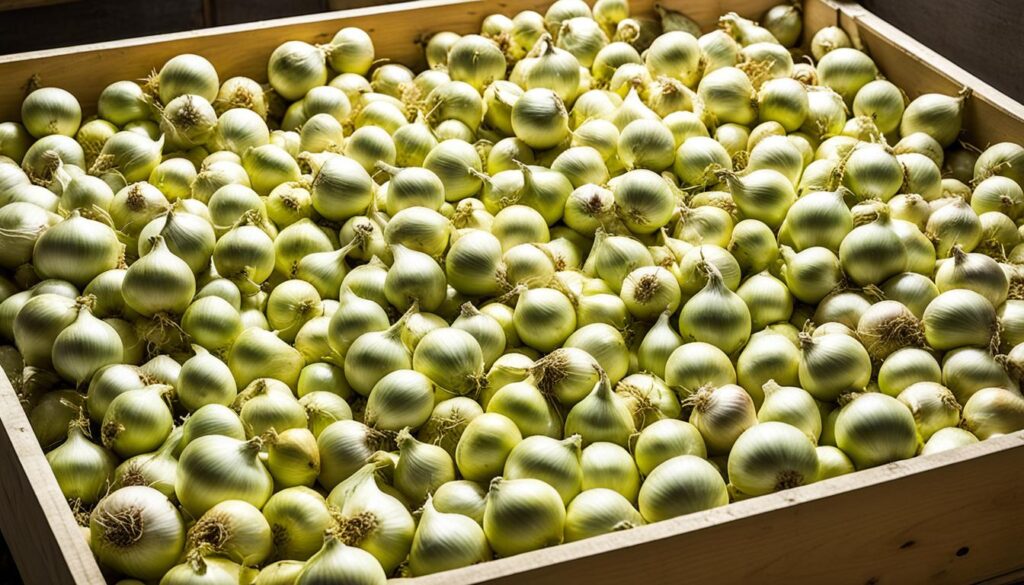
“Proper curing is essential for extending the storage life of onions and maintaining their quality. Taking the time to ensure the right temperature, humidity, and handling can make a big difference in how long your onions will last.”
Conclusion
To know when onions are ready to harvest, watch for signs like leaf count, soft neck, and the last leaf indicator. Harvesting in dry weather and curing onions before storing is key for great flavor and keeping them fresh. This way, I can pick my onions at the best time for top results.
Important tips for harvesting onions are to watch the plant’s growth and look for signs it’s ready. Also, handle the onions well after picking to keep them fresh and tasty. With these tips, I can harvest onions with confidence, getting the most from my crop.
Getting onions to grow well means knowing about their growth, what they need, and how to store them after. By keeping up with the latest advice, I can get better at growing onions. This leads to a big, quality harvest every year.
FAQ
How can you tell when onions are ready to harvest?
You can tell onions are ready to harvest by looking for a soft neck, when the tops fall over, and the last leaf indicator. It’s also key to harvest them in dry weather to avoid disease and keep them fresh for storage.
What are the signs of maturity to watch for in onion plants?
Look for maturity in onion plants by checking for at least 7 leaves, a soft neck, and the tops falling over. Also, make sure the last leaf to appear is dry.
What is the last leaf indicator, and why is it important?
The last leaf indicator is the newest leaf on the onion plant. Waiting for this leaf to dry before harvesting is important. Harvesting too early can cause the onions to rot in storage.
When is the best time to harvest onions?
Harvest onions in dry weather to avoid disease. Wait until 50% to 80% of the foliage has dried and fallen over before you pick them.
How can you tell when onions are ready to harvest?
Check for onion readiness by looking at the leaf count, soft neck, and fallen tops. Also, ensure the last leaf is dry and at least 50-80% of the foliage is dry and down.
What are the proper curing techniques for onions after harvesting?
Cure onions at 75 to 90 degrees Fahrenheit for two to four weeks to dry the skins and necks. This makes them less likely to rot in storage. After curing, trim the necks to 1 inch above the bulb and remove any bad onions before storing.
